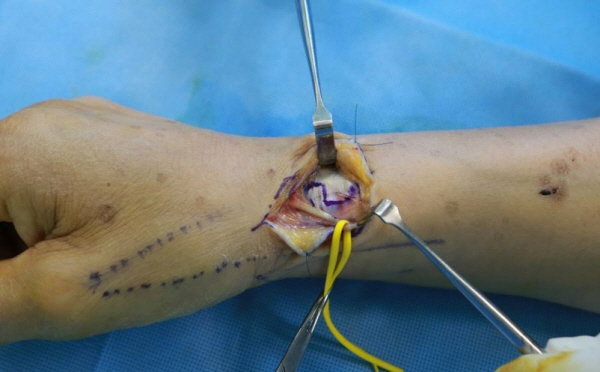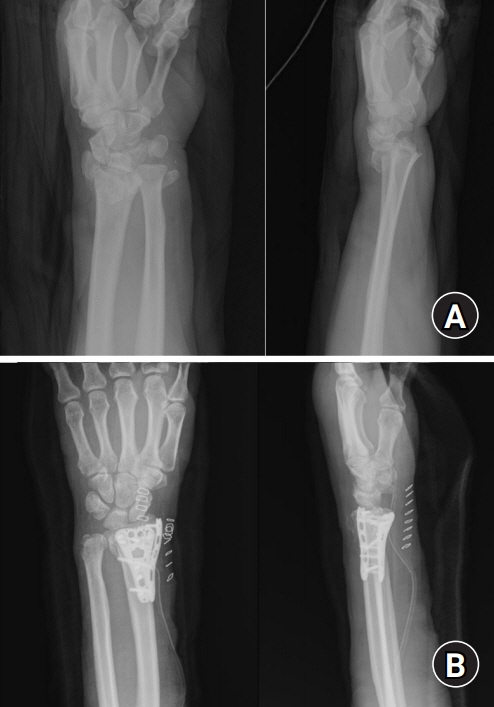Arch Hand Microsurg.
2021 Jun;26(2):93-99. 10.12790/ahm.21.0091.
The Usefulness of Radial Column Plate in Distal Radius Fracture: Indications and Results
- Affiliations
-
- 1Department of Orthopedic Surgery, Armed Forces Capital Hospital, Seongnam, Korea
- 2Department of Orthopedic Surgery, Busan National University Hospital, Busan National University School of Medicine, Busan, Korea
- 3Department of Orthopedic Surgery, Samsung Changwon Hospital, Sungkyunkwan University School of Medicine, Changwon, Korea
- 4Department of Orthopedic Surgery, Inje University Haeundae Paik Hospital, Inje University College of Medicine, Busan, Korea
- 5Department of Orthopedic Surgery, Bone Barun Hospital, Yangsan, Korea
- KMID: 2516153
- DOI: http://doi.org/10.12790/ahm.21.0091
Abstract
- Purpose
The most common surgical treatment for distal radius fracture is internal fixation using volar locking plates, but it is sometimes difficult to maintain reduction with them. Therefore, this research reports the results of surgical treatment with additional radial column plates.
Methods
We analyzed 12-month follow-up results in 100 cases. The patients had the B or C types of distal radius fractures, in accordance with AO classification, and underwent surgical treatment at our hospital from May 2013 to December 2019. There were 16 cases of B-type and 84 cases of C-type fractures. Out of these, 87 were treated with volar locking plates (V group) and 13 had additional radial column plates (VR group). The results of surgical treatment were examined clinically by measuring the disabilities of the arm, shoulder and hand (DASH) and Mayo wrist score, and radiologically by measuring the radial length, radial inclination, and volar tilt, before and after surgery.
Results
After treatment, the radiographic average in the V group showed a radial length of 12.3 mm, radial inclination of 20.2°, and volar tilt of 5.8°, while the VR group showed 11.6 mm, 22.3°, and 9.0° respectively. A statistically significant difference was found in the DASH score, and the DASH score showed good results in the VR group.
Conclusion
Additional radial column plate fixation is worth considering because it provides clinically and radiologically satisfactory results in treatment of B and C types distal radius fracture involving articular surface.
Keyword
Figure
Reference
-
1. Court-Brown CM, Caesar B. Epidemiology of adult fractures: a review. Injury. 2006; 37:691–7.
Article2. Karl JW, Olson PR, Rosenwasser MP. The epidemiology of upper extremity fractures in the United States, 2009. J Orthop Trauma. 2015; 29:e242–4.
Article3. Im JH, Lee JY. Pearls and pitfalls of the volar locking plating for distal radius fractures. J Hand Surg Asian Pac Vol. 2016; 21:125–32.
Article4. Blythe M, Stoffel K, Jarrett P, Kuster M. Volar versus dorsal locking plates with and without radial styloid locking plates for the fixation of dorsally comminuted distal radius fractures: a biomechanical study in cadavers. J Hand Surg Am. 2006; 31:1587–93.
Article5. Tang P, Ding A, Uzumcugil A. Radial column and volar plating (RCVP) for distal radius fractures with a radial styloid component or severe comminution. Tech Hand Up Extrem Surg. 2010; 14:143–9.
Article6. Dong WT, Lü ZB, Song M. Guiding role of three-column theory in manipulative reduction, small splint fixation and early rehabilitative exercises for Colles fracture. Zhongguo Gu Shang. 2014; 27:478–81.7. Rikli DA, Regazzoni P. Fractures of the distal end of the radius treated by internal fixation and early function: a preliminary report of 20 cases. J Bone Joint Surg Br. 1996; 78:588–92.8. Zhou J, Tang W, Li D, Wu Y. Morphological characteristics of different types of distal radius die-punch fractures based on three-column theory. J Orthop Surg Res. 2019; 14:390.
Article9. Rikli DA, Regazzoni P. The double plating technique for distal radius fractures. Tech Hand Up Extrem Surg. 2000; 4:107–14.
Article10. Helmerhorst GT, Kloen P. Orthogonal plating of intra-articular distal radius fractures with an associated radial column fracture via a single volar approach. Injury. 2012; 43:1307–12.
Article11. Jupiter JB, Lipton H. The operative treatment of intraarticular fractures of the distal radius. Clin Orthop Relat Res. 1993; (292):48–61.
Article12. Glickel SZ, Catalano LW, Raia FJ, Barron OA, Grabow R, Chia B. Long-term outcomes of closed reduction and percutaneous pinning for the treatment of distal radius fractures. J Hand Surg Am. 2008; 33:1700–5.
Article13. Barton T, Chambers C, Bannister G. A comparison between subjective outcome score and moderate radial shortening following a fractured distal radius in patients of mean age 69 years. J Hand Surg Eur Vol. 2007; 32:165–9.
Article14. Anderson JT, Lucas GL, Buhr BR. Complications of treating distal radius fractures with external fixation: a community experience. Iowa Orthop J. 2004; 24:53–9.15. Anderson MS, Ghamsary M, Guillen PT, Wongworawat MD. Outcomes after distal radius fracture treatment with percutaneous wire versus plate fixation: meta-analysis of randomized controlled trials. J Surg Orthop Adv. 2017; 26:7–17.16. Wei DH, Raizman NM, Bottino CJ, Jobin CM, Strauch RJ, Rosenwasser MP. Unstable distal radial fractures treated with external fixation, a radial column plate, or a volar plate: a prospective randomized trial. J Bone Joint Surg Am. 2009; 91:1568–77.17. Rhee PC, Medoff RJ, Shin AY. Complex distal radius fractures: an anatomic algorithm for surgical management. J Am Acad Orthop Surg. 2017; 25:77–88.18. Galle SE, Harness NG, Hacquebord JH, Burchette RJ, Peterson B. Complications of radial column plating of the distal radius. Hand (N Y). 2019; 14:614–9.
Article19. Grindel SI, Wang M, Gerlach M, McGrady LM, Brown S. Biomechanical comparison of fixed-angle volar plate versus fixed-angle volar plate plus fragment-specific fixation in a cadaveric distal radius fracture model. J Hand Surg Am. 2007; 32:194–9.
Article20. Jacobi M, Wahl P, Kohut G. Repositioning and stabilization of the radial styloid process in comminuted fractures of the distal radius using a single approach: the radio-volar double plating technique. J Orthop Surg Res. 2010; 5:55.
Article21. Fitoussi F, Ip WY, Chow SP. Treatment of displaced intra-articular fractures of the distal end of the radius with plates. J Bone Joint Surg Am. 1997; 79:1303–12.
Article
- Full Text Links
- Actions
-
Cited
- CITED
-
- Close
- Share
- Similar articles
-
- Surgical Indications for Distal Radius Fractures
- Failure of Distal Locking Screws in an Intraarticular Distal Radius Fracture Treated with Volar Locking Plate Fixation
- Rupture of the Extensor Pollicis Longus Tendon at the Proximal Screw of Volar Plate Fixation for Distal Radius Fracture: A Case Report
- Treatment of Fractures of the Distal Radius using Locking Compression Plate
- Surgical Treatment of Distal Radius Fractures and Treatment of Common Accompanying Lesions





